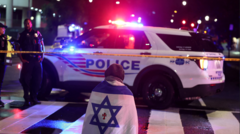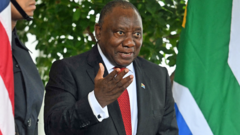The roadside memorial spotlighted in President Trump's video has drawn attention not only for its inaccurate representation but also for the racial tensions it has resurfaced in South Africa, where local perceptions of farmer safety and racial harmony differ greatly from Trump's narrative.**
Misrepresented Memorial: South African Community Reacts to Trump's Claims**

Misrepresented Memorial: South African Community Reacts to Trump's Claims**
President Trump’s video linking a South African road with alleged persecution of Afrikaners ignites local debate about race relations and the realities faced by farmers in South Africa.**
The P39-1 highway, a seemingly ordinary stretch of road in KwaZulu-Natal, South Africa, unexpectedly gained global attention following a controversial video released by former U.S. President Donald Trump. In this video, Trump asserted that the area represented a "burial site" for Afrikaners who have been victims of violence, an assertion that turned out to be misinformed.
The P39-1, connecting Newcastle and Normandein, was the site of temporary memorials erected in 2020 after the brutal murder of Roland Collyer's relatives, Glen and Vida Rafferty, which shocked the local farming community. Trump’s depiction of the site, often referred to as evidence of a supposed genocide against white farmers, has not only stirred international scrutiny but has also elicited a myriad of local reactions.
Residents, including Collyer, have expressed dismay over the video’s inaccuracies. The crosses that once stood along the road in remembrance of farm killings have long been removed, as local activists like businessman Rob Hoatson clarified that these were temporary symbols rather than a permanent memorial — a fact that Trump failed to acknowledge.
Collyer described the intention behind the memorial: to raise awareness about the violence against farmers. However, he emphasized that this unique instance of violence should not overshadow the complex racial dynamics in South Africa, where the majority of murder victims are black. He noted that the local community has experienced heightened racial tensions, with mixed feelings about the representation of their situation in Trump’s rhetoric.
Next, reactions from other locals reveal a different perspective. Many community members, such as 63-year-old Bethuel Mabaso, were surprised that their quiet neighborhood was thrust into the spotlight under such false pretenses. He expressed that their community is generally peaceful and has not seen similar violence since the Raffertys’ murders. Furthermore, farmworker Mbongiseni Shibe acknowledged the complicated legacy of race relations but noted a tendency towards collaboration and mutual respect in day-to-day interactions.
While Trump has offered asylum to Afrikaners and highlighted the plight of this demographic, local residents like Collyer remain committed to their community, reluctant to leave behind a legacy built over generations. Despite the fear for personal safety, Collyer and others are hopeful for reconciliation and cooperation among different racial groups in South Africa.
As local reactions contrast sharply with Trump’s narrative, the situation at the P39-1 road reveals the complexities of farm safety and racial relations in South Africa, a narrative that seems all too often oversimplified in international discourse.




















